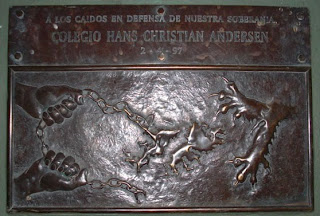Thursday, February 4, 2010
WHAT DO WE HOPE TO SEE IN THE FALKLANDS?
The Falkland Islands, called that by the British, are also called the Isla Malvinas, by the Argentineans. Indeed, the Argentineans have a rhyming slogan in Spanish – “Las Malvinas son Argentinas.“
We will be arriving at Stanley in the morning. It’s named after Lord Stanley, the former British Secretary of State for the Colonies. But in 1982, the Argentineans decided to reclaim what was theirs. The war lasted months and mostly in the Eastern Island, East Falkland Island. 649 Argentineans were killed in that war.
When I stopped by the memorial in Buenos Aires a few nights ago, the three men I met that sweltering evening said it was a waste of young lives. I agreed and still do but Argentina still claims it and I favor their claim despite how futile was that effort in 1982.
If you want a picture that captures the resistance, Holly found one not far from where I had that conversation in the dark of night.
A bronze plaque showed the British with outstretched claws, grabbing at the Eastern Falkland Island, and then there are the hands of Argentina trying to keep what they insist is theirs.
The sentiment abides that this land is Argentinean. Many and not just Argentineans resent the British presumption, particularly since, if they have their way, they’ll despoil the history and the entire way of life that attracts most of the folk on this ship.
It shouldn’t surprise you that, for Great Britain, this is all about the oil and gas they want to extract from these rough ocean waters.
It is a island with only a few thousand people who sheep farm and fish, and where it rains or snows 250 days of the year. We’ll report on the weather tomorrow but the island is known for wide swings in wind speed, temperature, wetness, and sunshine.
You may not think an island could make a living. But there are 500,000 sheep on these islands, and that’s a lot of wool. As for fishing, they bring in about $40 million, mostly squid.
For the naturalists, there are 120 species of birds, and penguins, particularly the gento, rockhopper, king and jackass (this is not a typo). I’ll send along a picture guide so you can figure out what penguin is what. There’s a special bird that caught my attention. It’s called the quark – and I thought that was a subatomic particle.
It shouldn’t surprise you that this was one of Darwin’s stops.
I don’t want you to think you can go just anywhere – as there are still land mines from the war in 1982.
Nor is this a small problem. There are 125 unexploded ordinance sites. The maps of where they put the explosives has been “misplaced.” There’s one such site near where you visit a penguin colony at the Gypsy Cove. Some smarter folk have tried to smuggle out the land mines as “souvenirs.”
You have to hope you don’t live next to that genius.
Sir Shackleton walked the beaches here considering how he would get to the South Pole and by what route.
Anyhow, we’re looking forward to going ashore by tenders in the morning and, as the ocean waves are now peaking at 12 feet, we are somewhat sobered at what that may be like. JPF
Subscribe to:
Post Comments (Atom)



No comments:
Post a Comment